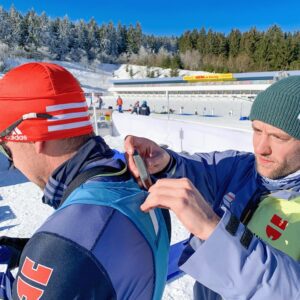Many of the companies I have spoken with utilised marker less motion capture and AI-aided computer vision for biomechanical analysis. However, physical sensors which feed data for analytics play an equally important role.
Alogo Analysis and Archinisis are two Swiss companies which rely on sensors for sports performance analysis. While Alogo have carved out a niche in Equestrian sports, Archinisis is largely focused on winter sports like (alpine) skiing and cross-country skiing.
However, as I’ll touch upon shortly- the data they capture goes beyond just analysing individual performances – it also aids in enriching the live broadcast stream.
It’s also worth pointing out a key difference between sensors and computer visions based analysis. Sensors can give an overall picture or a specific data point while not necessarily telling a player how their arms or legs moved.
Alogo Analysis:
David Deillon – a professional show jumping horse rider- founded Alogo Analysis in 2016 with an aim to disrupt equestrian sports which were stuck in the 1990s. Until Alogo came along, video replays were the only way that equestrian sports were analysed.
Alogo’s sensor-based technology – quite unique at this time – allows horse movements to be analysed with accuracy. Stride length, balance, jump height, heart rates and gait analyses are some of the key metrics that Alogo is able to capture and analyse. This in turn allows riders to move away from gut feelings and actually work with quantifiable information.
What is truly admirable is that a lot of work had to be done to validate and interpret the data. As no other sport was truly extracting data from an animal. Alogo worked with veterinarians to qualify the new data points. To put it in David’s words – “no one knew if a particular data point was good or bad and how it co-related to performance”.
Beyond analytics: the same data (example – pace of the racer) is also displayed during race broadcasts and has resonated very well with the viewing audience.
Furthermore, the associated app also helps engage fans via course visualisations and Alogo’s ghost rider technology. Ghost rider overlays the broadcast feed of two riders to allow fans to see the key moments which gave an advantage to the winner.
Ghost rider in action
In fact, the ghost rider concept can also find applications in other individual racing sports.
Finally, it’s worth noting that equestrian sports do face opposition from animal rights activist in relation to safety and cruelty. Alogo’s products help mitigate this opposition as its fatigue and gait tracking not only allows injuries to be identified but potentially prevented as well. In that sense, Alogo Analysis plays a key social role in the world of equestrian sports.
Archinisis:
Archinisis was founded in 2018 to bring sensor-based motion tracking technology to optimise coaching. The use case in the beginning was to provide performance analysis technology for cross-country skiing and biathlon The company aims to help coaches and simplify their lives with easy-to-use software and in the process doing away the need for a data or sports scientist.
There are various sensors available in the market. Many companies in the sportstech space use sensors to compute metrics like loads and fatigue which are then fed to the cloud for visualisation. However, most stop there i.e., they measure fatigue but don’t provide insights about performance and where an athlete can improve after. This is where Archinisis comes in.
Their sensors feed the data time in near real-time to the cloud which can be accessed for visualisation and analysis via an app. In addition, they also provide a customisable video overlay for all sports. With an additional device the videos can be automatically synced with the sensor data.

Archinisis has proved itself as 10 cross-country skiing athletes using its sensors, won medals during the 2022 Beijing Winter Olympics. In the 2022/2023 cross-country skiing season, over 40% of the top-10 positions were won by athletes training with their system.
Archinisis has primarily focused on skiing – cross country and alpine – but is also diversifying into other sports such as biathlon, ski-jumping, rowing and athletics . In the next phase, the company will work with broadcasters to display tracking data during the live broadcast. This will give more data and analysis to the commentators.
Final thoughts:
Both these companies are great examples of success being driven by founder with technical depth and knowledge in their field of choice. Not only are they helping improve athlete performance in their choice of sports but also enhancing the viewing experience for fans.